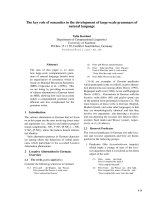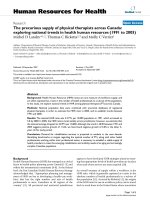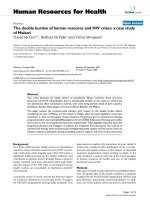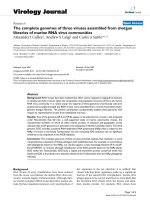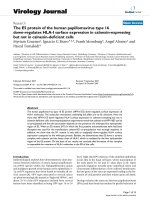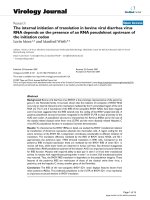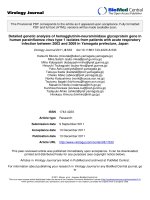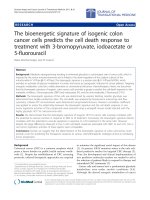Báo cáo sinh học: "The genetic control of ovariole in Sitophilus oryzae L is temperature sensitive" pptx
Bạn đang xem bản rút gọn của tài liệu. Xem và tải ngay bản đầy đủ của tài liệu tại đây (1017.76 KB, 18 trang )
Original
article
The
genetic
control
of
ovariole
number
in
Sitophilus
oryzae
L
(Coleoptera,
Curculionidae)
is
temperature
sensitive
AM
Grenier,
P
Nardon
INSA,
UA
INRA
227,
Laboratoire
de
Biologie
Appliquée,
Bât
4
06,
20,
avenue
A-Einstein,
69621
Villeurbanne
cedex,
France
(Received
3
May
1993;
accepted
29
April
1994)
Summary -
The
influence
of
genetical
and
epigenetical
factors
on
the
determinism
of
the
ovariole
number
was
studied
in
Sitophilus
oryzae.
This
weevil
normally
possesses
4
ovarioles
with
apical
bacteriomes
harbouring
symbiotes.
By
selecting
females
with
a
reduced
number
of
ovarioles,
the
genetic
control
of
this
trait
was
demonstrated
with
regard
to
the
easy
selection
of
this
character
and
its
similar
transmission
to
the
progeny
by
females
and
males.
Several
genes
could
be
implicated
and
a
weak
maternal
effect
cannot
be
rejected.
The
character
is
temperature
sensitive:
at
30°C,
abnormal
females
with
2
or
3
ovarioles
prevail,
and
conversely,
normal
females
appear
at
20°C.
The
reduction
of
the
number
of
ovarioles
is
correlated
with
a
decrease
in
fitness
(reduced
progeny
and
lighter
body
weight
of
females).
Only
ovary
formation
seems
to
be
affected,
because
a
higher
progeny
per
ovariole
in
abnormal
females
can
be
indicative
of
a
normal
yolk
production
in
the
fat
body.
Counting
bacteria
in
ovaries
shows
that the
regulation
of
symbiote
number
per
female
occurs
at
the
ovariole
itself
and
not
within
the
whole
insect.
Sitophilus
oryzae
/
ovariole
number
/
selection
/
genetic
control
/
temperature-
sensitive
character
Résumé -
Le
contrôle
génétique
du
nombre
des
ovarioles
chez
Sitophilus
oryzae
L
(Coleoptera,
Curculionidae)
est
sensible
à
la
température.
L’influence
de
facteurs
génétiques
et
épigénétiques
sur
le
déterminisme
du
nombre
des
ovarioles
a
été
étudiée
chez
Sitophilus
oryzae.
Ce
charançon
possède
normalement
4 ovarioles
terminés
par
un
bactériome
apical
hébergeant
des
symbiotes.
En
sélectionnant
les
femelles
ayant
un
nombre
réduit
d’ovarioles,
nous
avons
pu
démontrer
le
contrôle
génétique
de
ce
caractère :
.’
sélection
aisée
et
transmission
à
la
descendance
aussi
bien
par
les
femelles
que
par
les
mâles. Plusieurs
gènes
pourraient
être
impliqués
et
un
léger
effet
maternel
se
manifeste
par
ailleurs.
Le
caractère
est
thermo-sensible :
à
30°C,
les
femelles
anormales
à
2
ou
3 ovarioles
sont
majoritaires,
alors
que,
à
20°C,
le
phénotype
normal
prédomine.
La
réduction
du
nombre
des
ovarioles
est
corrélée
avec
une
diminution
de la
fitness
(descendance
réduite
et
poids
corporel
des
femelles
plus
faible).
Seule
la
formation
de
l’ovaire
semble
être
affectée,
car
une
fertilité
plus
grande
par
ovariole
chez
les
femelles
anormales
indiquerait
une
production
normale
de
vitellus
dans
le
corps
adipeux.
Les
dénombrements
de
bactéries
dans
les
ovaires
ont
montré
que
la
régulation
du
nombre
de
symbiotes
par femelle
intervient
au
niveau
de
l’ovariole
lui-même,
plutôt
qu’au
niveau
de
l’insecte
entier.
Sitophilus
oryzae
/
nombre
d’ovarioles
/
sélection
/
contrôle
génétique
/
caractère
thermosensible
INTRODUCTION
Sitophilus
oryzae,
the
rice
weevil,
is
a
major
cereal
pest.
The
factors
affecting
the
biotic
potential
have
been
studied
by
several
authors
(Birch,
1945;
Segrove,
1951;
Nardon,
1978a),
but
little
attention
was
focused
on
genetic
factors,
particularly
those
affecting
reproduction.
The
present
study
completes
previous
observations
concerning
the
variability
of
the
structure
of
the
female
genital
tract
and
the
influence
of
various
factors
(Nardon
and
Grenier,
1983).
S
oryzae
females
have
2
ovaries,
each
divided
into 2
ovarioles.
This
structure
is
typical
of
the
Sitophilus
genus,
as
well
as
of
the
majority
of
Rhynchophorinae
(Murray
and
Tiegs,
1935;
Vernier,
1970;
Ganesalingam,
1974).
At
the
anterior
tip
of
each
ovariole,
a
bacteriome
containing
intracellular
bacteria
is
formed
(Mansour,
1930;
Nardon,
1971).
This
apical
bacteriome
disappears
in
the
absence
of symbiotes
(Nardon,
1973).
On
account
of
their
economic
importance,
these
weevils
have
been
extensively
studied
and
seem
to
possess
great
genetic
stability
with
regard
to
the
few
morpho-
logical
anomalies
which
have
been
observed.
In
S
granarius,
a
wing
malformation
was
noticed
by
Strong
(1959),
and
in
S
oryzae
2
mutations
have
been
described:
one
affecting
antenna
and
called
’fused
antennae’
(Campbell-Brown
and
Champ,
1971)
and
the
other
modifying
rostrum
and
elytra
morphology
(Nardon
and
Nar-
don,
1983).
In
another
Curculionidae,
Hypera
postica,
some
females
with
5
ovarioles
were
observed
in
a
natural
population
by
Hower
(1971)
but
with
a
very
low
fre-
quency
(0.1-0.2%).
The
same
observation
has
been
made
for
S
oryzae
(Nardon
and
Grenier,
1983).
However,
after
irradiation,
different
kinds
of ovarial
anomalies
could
be
obtained:
either
of
functional
(absence
of
oogenesis)
or
structural
origin
(variable
ovariole
number)
(Nardon,
1978b;
Nardon
and
Grenier,
1983).
Structural
anomalies
were
the
most
frequent
when
young
larvae
were
irradiated
during
ovary
formation
since
irradiation
acts
directly
on
the
differentiation
process.
The
persistence
of
these
anomalies
in
the
next
generations,
as
well
as
the
appearance
of
abnormal
females
in
the
progeny
of irradiated
fathers
suggested
a
genetic
determinism.
In
Drosophila,
genetic
studies
have
shown
that
the
ovariole
number
varies
from
1
strain
to
another
often
with
a
geographical
pattern
and
seems
to
be
under
the
control
of
a
polygenic
system
(De
Scheemaeker-Louis,
1970,
1971;
Thomas-Orillard,
1975;
Capy
et
al,
1993).
In
some
Scarabaeinae,
Pluot
(1979)
observed
reduction
of
the
number
of
ovarioles
during
the
larval
development,
from
6
primitive
ovarioles
to
only
1
definitively
formed
ovariole.
This
phenomenon
is
genetically
controlled
and
is
the
result
of
a
regressive
phylogenic
evolution.
In
S
oryzae,
a
newly
introduced
laboratory
strain
was
found
to
possess
some
females
with
only
2
or
3
ovarioles.
We
thought
that
this
would
be
a
good
opportunity
to
start
selection
on
the
reduction
of
the
ovariole
number
with
this
strain,
in
order
to
study
the
genetic
control
(chromosomal
and
epigenetical)
in
the
determinism
of
the
ovariole
number
in
Sitophilus.
With
such
a
strain,
which
normally
presents
a
reduced
number
of
ovarioles,
we
had
the
advantage,
contrarily
to
structural
anomalies
previously
artificially
obtained
in
the
laboratory,
of
rejecting
additional
effects
of
irradiation
treatment.
It
was
also
interesting
to
study
the
influence
of
the
reduction
of
ovariole
number
on
fertility
and
female
body
weight,
as
well
as
on
the
regulation
of
the
number
of
ovarial
symbiotes.
During
experiments
on
selection,
we
found
that
a
decrease
in
temperature
modified
ovariole
distributions,
so
we
studied
the
effect
of
temperature
on
this
character
more
carefully.
MATERIALS
AND
METHODS
Breeding
and
test
for
temperature
influence
The
S
oryzae
strain
used
for
selection
(called
the
W
strain)
was
found
on
wheat
in
a
grocery
in
Lyon
and
breeding
was
conducted
on
wheat,
in
latticed
plastic
boxes
kept
in
ventilated
incubators
at
27.5°C
and
75%
RH
(Laviolette
and
Nardon,
1963).
For
temperature
effects
on
the
ovariole
number,
4
temperatures
were
tested:
20,
23.5, 27.5
and
30°C.
In
order
to
limit
the
’female
effect’,
we
tested
homogeneity
of
3
series
of
females
which
we
first
allowed
to
lay
eggs
at
27.5° C
for
4
d,
before
each
was
transferred
to
another
temperature
for
a
1-week
egg-laying
period.
Selection
procedure
and
crossings
At
its
arrival
in
the
laboratory,
the
W
strain
presented
5
females
out
of
197
with
structural
ovarial
anomalies:
4
females
with
3
ovarioles
and
1
with
2
ovarioles.
The
selection
was
conducted
from
the
progeny
of
these
abnormal
females.
At
the
beginning
of
the
selection,
only
females
with
1,
2
and
3
ovarioles
were
allowed
to
give
progeny
for
the
next
generation
(Go
to
Gg).
After
this
time,
selection
was
only
applied
in
G
12
,
G
35
and
G
36
,
when
the
percentage
of
abnormal
females
was
decreasing
(see
table
I).
For
genetic
experiments,
virgin
adults
were
obtained
by
isolating
oviposited
wheat
kernels
in
cavities
bored
in
a
polyurethane
plate
and
covered
with
a
glass
sheet.
Egg-laying
density
was
chosen
so
as
to
have
only
1
imago
emerging
from
a
kernel.
After
sex
determination
and
before
crossings,
weevils
were
kept
separated
on
wheat
until
sexual
maturity.
Crosses
were
effected
between
the
abnormal
line
selected
for
a
reduced
number
of
ovarioles
(called
A
line)
and
the
original
normal
line
with
4
ovarioles
(called
N
control
line
and
bred
without
selection).
These
crosses
were
conducted
at
27.5°C
with
generation
G6,
at
the
beginning
of
the
selection,
and
with
G
50
,
when
the
character
was
well
established
in
the
population.
For
each
experiment
we
studied
parental
Fl
and
F2
hybrid
generations
as
well
as
the
reciprocal
crosses
in
G
50
.
The
phenotype
could
be determined
easily
in
females
by
dissecting
ovaries,
but
in
males,
we
named
the
brothers
of
females
of
N
line
with
4
ovarioles
’normal’
males,
and
those
of
females
with
1-3
ovarioles
’abnormal’
males .
Determination
of
biological
parameters
Fertility
The
whole
progeny
of
a
female
was
difficult
to
measure
because
the
total
egg-laying
time
was
longer
than
30
weeks.
Therefore,
the
fertility
was
estimated
by
the
mean
number
of
progeny
per
female
per
day
for
a
1-week
egg-laying
period,
at
the
time
of
maximal
fertility
(2
or
3
weeks
after
adult
emergence
from
the
grain).
Sex
ratio
Total
female
and
male
numbers
were
noted
throughout
the
experiments,
but
the
sex
ratio
was
not
taken
into
account
in
the
results,
because
it
remained
stable
(close
to 1).
Weight
’
Adult
females
were
individually
weighed
on
an
electromagnetic
balance
(Setaram
- y21)
with
a
10-
2
mg
precision.
Ovariole
number
After
weighing,
females
were
dissected
in
a
Yeager
solution
(pH
6.8,
pO
400
mosm;
Nardon
and
Grenier,
1983).
The
last
tergite
was
lifted
with
small
forceps
to
extract
the
genital
apparatus
in
toto.
In
the
’abnormal’
line,
ovaries
could
show
from
0
to
4
ovarioles.
Determination
of symbiote
number
in
ovaries
Symbiotes
are
rod-shaped
and
more
or
less
flexuous
bacteria
(Nardon,
1971).
They
are
located
in
a
bacteriome
at
ovariole
tips
in
trophocytes
and
oocytes.
Their
number
was
estimated
by
counting
in
a
Thoma’s
cell
under
a
phase-contrast
microscope.
For
each
female,
ovaries
were
crushed
in 0.1
ml
Yeager
solution.
At
the
same
time,
the
morphology
of
the
ovariole
tip
(single
or
double)
was
also
recorded.
RESULTS
Selection
of
the
’reduced
number
of ovarioles’
character
at
27.5°C
Selection
of
the
abnormal
A
line
was
studied
on
50
successive
generations.
Dissec-
tions
of
females
were
effected
on
each
generation
at
the
beginning
of
the
selection,
but
only
on
some
of
them
at
the
end.
Results
are
reported
in
table
I,
while
the
rel-
ative
evolutions
of
ovariole
mean
numbers
in
both
A
line
and
N
control
line
appear
in
figure
1.
Heterogeneous
numbers
of
dissected
females
in
successive
generations
were
due
to
2
different
strategies:
genetic
experiments
with
numerous
dissections
and
simple
records
of
selection
with
few
females.
At
Go,
only
4
females
with
3
ovarioles
and
1
with
2 ovarioles
were
observed
in
the
total
population
of
197
females
(ovariole
mean
number 7
=
3.97).
By
selecting
abnormal
females
for
egg
laying,
we
obtained
33%
of
abnormal
females
in
G2
(x
=
3.60)
and
6
generations
after
(G
8
),
we
got
a
line
with
nearly
97%
of
females
having
a
reduced
ovariole
number
(x
=
2.24).
After
this
time,
every
female
of
the
progeny
contributed
to
the
next
generation
without
selection
of
females
with
a
low
number
of
ovarioles
and
percentages
of
abnormal
females
remained
around
87%.
With
just
a
new
selection
of
abnormal
females
at
G
12
,
the character
stabilized
near
95%
anomalies
without
selection
until
G
34
.
At
G
35
and
G
36
,
selection
was
practised
because
the
percentage
of
abnormal
females
was
under
87%.
After
this
time
no
more
selection
was
applied,
and
at
the
end
of
the
experiment
(G5o
)
a
well-
established
character
was
obtained
with
96.8%
ovarial
anomalies
and
an
ovariole
mean
number
of
2.21.
A
minimum
of
2
ovarioles
seemed
to
be
an
asymptotic
value.
The
effect
of
selection
could
also
be
observed
on
the
progeny
of
females
showing
a
normal
phenotype
with
4
ovarioles
(table
II).
The
mean
number
of
ovarioles
decreased
according
to
the
generation
from
3.97
(Go)
to
2.25
(G50).
At
each
generation,
matings
were
effected
between
brothers
and
sisters,
but
only
progenies
of
females
with
4
ovarioles
were
analyzed
in
this
case.
We
found
that
mothers
with
4
ovarioles
gave
abnormal
daughters
and
anomaly
percentages
increased
throughout
selection.
It
was
evident
that
the
male
genotype
has
been
modified
by
selection;
nevertheless,
in
G
SO
,
the
high
percentage
of
abnormal
daughters
cannot
be
explained
by
genotypic
modification
of
males
only.
At
this
generation,
crosses
between
females
with
4
ovarioles
and
abnormal
males
would
give
progeny
similar
to
Fl
hybrids
(see
AN
cross
in
table
IV
below)
with
54%
anomalies,
but
we
obtained
98%
anomalies,
like
in
crosses
between
abnormal
females
and
males.
Moreover,
we
could
verify
with
hybrids
between
abnormal
selected
females
in
G
SO
and
males
from
the
normal
line,
that
at
this
time,
the
anomaly
percentage
is
intermediate
between
parents
(44%).
Therefore,
the
genotype
of
these
females
was
modified,
even
if
their
phenotype
was
normal.
At
each
generation,
we
could
also
observe
a
relationship
between
the
proportion
of
females
with
3
ovarioles
and
the
proportion
of
females
with
4
and
2
ovarioles.
This
relation
could
be
expressed
by
the
following
formula:
where
the
frequency
of
3
ovariole
females
is
about
the
square
root
of
the
product
of
frequencies
of
females
with
2
and
4
ovarioles
(geometrical
mean).
These
results
proceeded
from
observed
ratios.
At
the
beginning
of
the
selection,
females
with
4,
3
and
2
ovarioles
were
in
the
ratio
9: 3:
1 in
G3
(X2
=
1.77,
2
df ),
4: 2:
1 in
G4
(X2
=
0.74,
2
df ),
1:1:
1 in
GS
(x
2
=
0.68,
2
df)
and
after
this
time,
the
proportions
were
inverted.
For
example,
they
were
1: 2:
4 (X2
=
0.61,
2
df)
in
G9,
1: 3:
9 (
X2
=
1.20,
2
df)
in
G
12
,
1: 4: 16
(XZ
=
0.57,
2
df )
in
G
18
and
1: 5: 25
(X2
=
0.36,
2
df )
in
G
SO
.
The
X2
tests
calculated
on
23
generations
(observations
on
15 562
females)
showed
that
the
experimental
ratios
were
compatible
with
the
theoretical
ones:
with
2
df ,
X2
=
5.99
at
the
5%
significance
level.
Crosses
between
normal
and
reduced
ovariole
number
lines
at
27.5°C
Crosses
at
the
G6
generation
Crosses
between
N
and
A
lines
were
conducted
at
27.5°C,
and
results
appear
in
table
III.
At
the
6th
generation,
the
anomaly
percentage
was
only
about
61%
in
the
parental
A
line
(x
=
3.11).
In
Fl
hybrids,
distributions
of
ovarioles
in
both
reciprocal
crosses
were
not
significantly
different
at
the
5%
level
(x2
=
4.09;
2
df)
but
they
were
very
different
from
the
parental
A
population:
X2
=
187.7
for
the
9
A
x
(f
N
(AN)
cross
and
X2
=
346.7
for
the
9
N
x
d’
A
(NA)
cross,
with
2
df.
Therefore,
the
ovariole
mean
numbers
were
both
very
close
(3.75
in
AN
and
3.80
in
NA)
but
higher
than
arithmetical
(x
=
3.54)
or
geometrical
(g
=
3.51)
parental
means.
Therefore,
from
this
experiment,
it
could
be
thought
that
neither
sex-linked
effects
nor
epigenetical
factors
were
involved.
As
egg-laying
Fl
females
had
heterogeneous
phenotypes
(4,
3
or
2
ovarioles),
the
F2
obtained
was
difficult
to
analyse.
We
have
thus
reported
in
table
III
only
the
composition
of the
F2
produced
by
Fl
females
with
4
ovarioles
in
order
to
appreciate
the
’disjunction’
of
the
character.
It
seemed
more
important
in
AN
(hybrids
which
inherited
the
abnormal
mother
cytoplasm)
than
in
NA
(hybrids
with
a
normal
cytoplasm).
Therefore,
the
smaller
number
of
ovarioles
in
AN
(x
=
3.45)
than
in
NA
(x
=
3.81)
may
suggest
a
weak
maternal
effect.
Crosses
at
the
G
50
generation
These
results
appear
in
table
IV.
At
the
50th
generation
of
selection,
the
abnormal
line
(A)
reached
95%
anomalies
and
the
normal
line
(simultaneously
bred
but
without
selection)
had
only
2.8%
anomalies.
It
could
be
noted
that
the
original
line
N
did
not
vary,
because
the
ovariole
mean
number
stayed
unchanged
between
Go
and
G
50
(G
o
x
=
3.97
and
G
50 T
=
3.96).
In
Fl,
AN
and
NA
reciprocal
hybrids
showed
anomaly
percentages
and
ovariole
mean
numbers
which
were
intermediate
between
those
of
parents
(arithmetical
mean x
=
3.13
and
geometrical
mean g
=
3.02).
It
is
noteworthy
that
the
2
distributions
were
significantly
different
(XZ
=
9.87;
2
df,
p
<
0.01),
as
well
as
their
mean
numbers
of
ovarioles
(e
=
2.47).
The
Fl
hybrids
have
abnormal
cytoplasm
(AN)
and
showed
more
anomalies
than
the
reciprocal
(perhaps
due
to
a
maternal
effect
?).
The
mean
number
of
ovarioles
of
9
AN
x
(f
AN
F2
progeny
(obtained
from
a
random
sample
of
Fl
females
with
4,
3
or
2
ovarioles)
was
not
significantly
different
from
Fl
values
(E
=
1.20
for
AN
Fl
and
e
=
0.12
for
NA
F1).
By
comparing
every
ovariole
mean
number
in
the
different
crosses,
we
got
significant
differences
as
follows: ! P AA
<
x BCNAxA
<
!(FlAN
=
F2
=
Fl
N
p)
<
!BCANxN
<
!PNN.
This
relation
is
typical
of
a
polygenic
character,
but
nevertheless
back-crosses
had
ovarial
anomaly
percentages
which
were
intermediate
between
those
of
the
Fl
hybrid
and
those
of
the
parent
used
in
the
cross
(27.85%
anomalies
in
Q
AN
x
d’
N
and
76.21%
in 9
NA
x
d’
A).
Theoretical
ovariole
mean
numbers
in
back-crosses
could
be
estimated
by
the
means
between
Fl
hybrids
and
parents
and
were
very
close
to
the
observed
values:
-
in
9 AN
x
d’
NN: x
=
3.61
or g
= 3.59
versus
3.62
observed;
-
in
Q NA
x
c3’
AA:
x
=
2.78
or
=
2.74
versus
2.70
observed.
In
the
same
analysis,
the
F2
distribution
can
be
treated
as
a
mixture
with
1/4
N
genotype,
1/4
A
genotype
and
1/2
Fl
genotype.
Temperature
influence
on
ovariole
number
The
effect
of
temperature
on
the
’reduced
ovariole
number’
character
was
studied
at
2
different
times
of
selection:
in
the
12th
and
23rd
generations.
In
G
12
,
the
selected
character
was
well
established
(anomaly
percentage
higher
than
90%)
and
the
ovariole
distribution
was
stable
for
several
generations
(see
table
I).
After
egg
laying,
grains
were
kept
at
2
different
temperatures:
27.5°C
(normal
temperature
for
laboratory
weevil
breeding)
and
23°C.
These
results
appear
in
table
V.
When
the
temperature
decreased
from
27.5
to
23°C,
the
distribution
of
ovarioles
in
the
progeny
was
modified:
percentage
of
normal
females
increased
from
5.9
to
24.7%
while
the
percentage
of
2
ovarioles
was
halved
(74.5
to
35.6%)
and
that
of
3
ovarioles
doubled
(17.3
to
39.6%).
The
mean
ovariole
number
increased
from
2.27
to
2.89
ovarioles
per
female.
This
study
was
carried
out
on
4
successive
generations
by
selecting
progeny
of
females
with
2
and
3
ovarioles.
Ovariole
mean
numbers
observed
in
Fl
stayed
nearly
unchanged
in
F2
and
F4,
with
only
the
same
decrease
in
ovariole
mean
numbers
at
the
2
temperatures,
due
to
the
selection
pressure.
In
G
23
,
for
a
better
study
of
the
effects
of
temperature
on
the
character
expression,
egg
laying
and
larval
development
were
performed
at
20,
23.5,
27.5
and
30°C
(temperatures
compatible
with
insect
development).
To
avoid
’female
effects’,
progenies
of
the
same
females
were
compared
at
27.5°C
and
at
another
temperature.
The
3
series
were
homogeneous
at
27.5°C
(X2
=
4.26
with
4
df ),
and
so
the
results
were
grouped.
These
results
are
reported
in
table
VI.
Distributions
were
clearly
different
as
a
function
of
temperature
(x
z
=
540
with
6
df;
p
<
0.001).
The
increase
of
temperature
enhanced
the
expression
of
the
character
(55.93%
ovarial
anomalies
at
20°C
versus
99.28%
at
30°C)
and
modified
the
ovariole
distribution
(26.78%
females
with
2
ovarioles
at
20°C
versus
94.96%
at
30°C,
for
example).
There
was
a
negative
linear
correlation
between
ovariole
mean
number
and
temperature
(r
=
-0.992).
Relationships
between
reduced
number
of
ovarioles
and
biological
pa-
rameters
Fertility
For
both
A
and
N
lines,
we
represented
the
mean
number
of
the
progeny
obtained
per
female
and
per
d,
at
the
time
of
maximal
fertility,
as
a
function
of
the
ovariole
number
in
females.
Different
selection
times
were
considered,
C
12
,
G
29
and
G5o
(table
VII).
Selection
on
the
A
line
also
seemed
to
reduce
the
fertility
because
the
observed
values
in
the
A
line
were
always
much
lower
than
in
the
unselected
N
line.
Nevertheless,
although
weaker,
the
fertilities
obtained
with
the
selected
line
could
be
compared
with
each
other
because
females
are
the
same
age
at
egg-laying
time
and
experiments
were
conducted
in
the
same
abiotic
conditions.
We
noted
a
linear
correlation
between
the
progeny
number
per
female
and
the
number
of
ovarioles
of
the
mother
(all
correlation
coefficients
were
close
to
1).
In
the
abnormal
line,
we
also
observed
that
for
the
same
ovariole
number,
there
was
a
tendency
to
a
fertility
restoration
across
generations
which
might
be
due
to
natural
selection.
Female
body
weight
To
investigate
the
effect
of
ovariole
number
on
female
weight,
in
the
G
42
generation,
we
weighed
and
then
dissected
2
female
samples
(A
and
N
lines).
The
results
appear
in
table
VIII.
In
the
A
line,
mean
weights
of
the
3
series
(4,
3
and
2
ovarioles)
were
not
significantly
different
from
each
other
at
the
5%
level
(t
<
0.58),
but
were
very
different
from
the
N
line
(t
from
4.6
to
12.10).
In
the
selected
A
line,
the
ovariole
number
of
females
did
not
appear
to
have
any
influence
on
weight,
but
the
body
weights
of
the
females
were
significantly
lower
than
those
of
N
line
females.
Ovarial
symbiote
number
per
female
The
ovarial
bacteriome,
which
is
located
at
the
tip
of
each
ovariole,
is
filled
with
symbiotes.
This
bacteriome
generally
appears
as
a
single
structure.
In
the
A
line,
when
the
ovary
could
not
differentiate
into
2
entire
ovarioles,
the
apical
bacteriome
could
sometimes
be
divided,
and
the
unique
ovariole
showed
2
apical
more
or
less
well-separated
bacteriomes.
Morphological
studies
of
these
phenomena
were
made
by
Nardon
and
Grenier
(1983).
The
symbiote
density
per
female,
as
well
as
the
apical
bacteriome
aspect,
were
studied
as
a
function
of
ovariole
number
at
the
G
50
generation,
and
the
results
are
reported
in
table
IX.
When
apical
bacteriomes
were
normal
(single),
the
female
had
a
symbiote
number
nearly
proportional
to
the
ovariole
number.
The
correlation
coefficient
was
0.998
and
the
regression
line
of
symbiote
number
per
female
(y)
as
a
function
of
the
ovariole
number
(x)
was
of
the
form:
&dquo;’
.
In
females
with
2
ovarioles,
but
when
the
bacteriome
was
divided,
even
partially,
the
symbiote
number
per
ovariole
was
twice
as
high.
DISCUSSION
Genetic
control
of
the
ovariole
number
In
Drosophila,
the
study
of
the
influence
of
irradiation
on
genesis
of
the
female
gen-
ital
apparatus
(Geigy,
1931;
Aboim,
1945)
showed
that
its
differentiation
is
largely
independent
of
the
germ
cells.
Nevertheless,
in
the
absence
of
germ
cells,
the
ovari-
oles
never
develop.
Therefore,
according
to
Abo
ï
m,
the
complete
morphogenesis
of
ovaries
results
from
an
interaction
between
germ
cells
and
mesodermal
cells.
In S
oryzae,
the
genesis
of
ovaries
was
described
by
Murray
and
Tiegs
(1935)
and
Tiegs
and
Murray
(1938).
In
the
early
embryo,
the
germ
cells
arise
by
migration
of
cleavage
cells
into
the
periplasm,
at
the
posterior
pole
of
the
egg,
and
become
associated
with
symbiotic
bacteria.
The
future
bacteriocytes
of
ovaries
also
develop
very
early
and,
when
the
germ
band
is
formed,
they
become
associated
with
the
germ
cells.
At
the
end
of
the
2nd
day,
the
germ
cells
come
in
close
contact
with
the
adjacent
coelomic
sacs
and
their
mass
divides
into
right
and
left
halves.
The
investing
sheath
of
the
gonad
arises
from
the
splanehnic
wall
of
the
posterior
coelomic
sac.
The
genital
ducts
develop
on
the
4th
day
from
the
mesodermal
cells
that
ensheath
the
gonad.
Shortly
before
the
larva
emerges,
a
pair
of
solid
stalks
are
formed
at
the
base
of
the
9th
segment
where
they
impinge
on
the
epidermis.
Therefore,
in
the
young
larva,
rudimentary
ovaries
appear
as
2
spherical
bodies
embedded
in
the
fat
body.
These
ovaries
grow
and
divide
into 2
pear-shaped
bodies
which
rapidly
expand
during
the
larval
stage.
In
the
early
prepupa,
the
development
proceeds
more
rapidly,
the
stalks
lengthen
and
a
lumen
is
formed.
The
imaginal
disk
differentiates
into
vagina
and
oviduct.
During
pupation,
the
ovarial
tubules
elongate
and
bacteriomes
containing
intracellular
symbiotes
are
formed
at
the
tip
of
each
ovariole
(Mansour,
1930;
Nardon,
1971).
They
disappear
in
the
absence
of
symbiotes
(Nardon,
1973).
The
ovary
divides
from
the
apex
to
the
oviduct,
and
all
intermediate
structures
can
be
found
from
4
to
2
typical
ovarioles
(Nardon
and
Grenier,
1983).
This
suggests
a
factor
of
division
acting
at
the
apex
of
ovaries,
perhaps
on
the
terminal
filament,
as
proposed
by
King
et
al
(1968)
and
Eiche
(1972)
in
Drosophila,
where,
during
ovarial
morphogenesis,
the
terminal
filament
seems
to
determine
of
the
ovariole
number.
Such
a
phenomenon
probably
occurs
in
Sitophilus.
From
this
description,
it
appears
that
the
formation
of
ovaries
results
from
3
main
events.
In
the
absence
of
germ
cells,
it
is
probable
that
the
rudiment
of
ovaries
is
not
formed
in
the
egg,
and
this
would
explain
the
fact
that
some
females
are
completely
devoid
of
ovarioles
(table
I).
This
is
the
first
level
of
control.
The
second
level
is
the
division
of
the
mass
of
germ
cells.
In
the
absence
of
this
division,
we
obtain
females
with
only
1
ovariole
(table
I).
The
third
level,
and
the
more
frequently
affected,
is
in
the
larva
and
the
young
pupa,
where
the
single
ovaries
may
divide.
When
the
2
rudimental
ovaries
divide,
4
ovarioles
are
obtained,
when
only
one
divides,
3
ovarioles
are
formed,
and
only
2
ovarioles
occur
in
the
absence
of
division.
In
the
S
oryzae
female,
our
results
clearly
show,
as
previously
expected
(Nardon
and
Grenier,
1983),
the
presence
of
a
genetic
determinism
of
the
number
of
ovarioles.
This
character
is
easily
affected
by
selection
and,
at
27.5°C,
only
8
generations
were
necessary
to
decrease
the
mean
number
of
ovarioles
from
3.97
to
2.24,
with
no
more
reliable
progress
afterwards.
The
genetic
control
can
be
demonstrated
by
crosses
in
the
G6
and
C
50
generations,
since
males
are
as
able
as
females
to
transmit
the
genetic
factor(s)
to
their
daughters.
No
sex-linked
effect
is
detectable.
The
question
arises
as
to
the
nature
of
the
genetic
system
of
control
involved.
In
G
so
,
the
Fl
values
are
significantly
different
from
each
other
at
the
5%
significance
level,
and
therefore,
it
is
possible
that
a
maternal
effect
also
occurs.
If
we
consider
the
complexity
of
the
morphogenesis,
this
suggests
the
probable
intervention
of
several
genes,
which
could
be
reinforced
by
the
observation
of
the
following
relationship
between
means,
evoking
a
polygenic
system:
In
Drosophila
melanogaster,
numerous
studies
have
dealt
with
the
influence
of
the
genome
on
the
ovariole
number
(Robertson,
1957;
Teissier,
1958;
Melou,
1961).
David
(1961)
showed
that
the
ovariole
number
character
was
rapidly
and
completely
transmitted
by
males
and
depended
on
nuclear
polygenic
hereditary
factors.
De
Scheemaeker-Louis
(1970)
described
a
polygenic
system
where
the
estimated
number
of
genes
varied
between
4
and
12,
12
being
the
most
probable
value.
Thoma,s-Orillard
(1975)
located
the
genes
on
chromosomes
II
and
III.
These
genes
have
additive
effects
with
interactions
of
dominance
type,
as
shown
by
a
positive
correlation
between
high
number
of
ovarioles
and
numerous
dominant
genes
(Thomas-Orillard,
1982).
A
maternal
effect
associated
with
the
presence
of
a
picornavirus
also
occurs
(Thomas-Orillard,
1984;
Thomas-Orillard
and
Jeune,
1985)
which
increases
the
number
of
ovarioles,
and
at
the
same
time
reduces
the
mean
development
time
and
gives
heavier
females.
Evidence
for
temperature
sensitivity
of
the
character
In
Sitophilus,
the
’reduced
ovariole
number’
character
was
enhanced
by
a
tem-
perature
increase
(remaining
in
biological
conditions),
leading
to
a negative
linear
correlation
between
the
mean
of
ovariole
number
and
temperature.
Penetrance
and
expressivity
of
the
character
varied
as
a
function
of
temperature:
at
30°C,
the
pene-
trance
was
almost
complete
(95%)
with
most
of
the
females
with
2
ovarioles,
while
at
20°C
the
penetrance
only
reached
56%
with
females
having
2
or
3
ovarioles
in
nearly
equal
quantity.
The
different
expressivity
(2
or
3
ovarioles)
depends
on
the
moment
when
the
division
is
elicited
or
suppressed.
This
temperature-sensitive
effect
can
be
compared
with
Wool
and
Mendlinger’s
observations
(1973)
on
a
spontaneous
morphological
mutation
in
Tribolium
casta-
neum
larva
and
pupa:
3
or
4
urogomphi
could
be
seen
on
the
terminal
abdominal
segments
in
mutants
instead
of
2
in
normal
insects.
The
penetrance
of
the
gene
was
variable:
incomplete
at
30°C
and
full
at
25°C.
Many
temperature-sensitive
mutations
have
been
described
in
Drosophila:
in
mutations
affecting
pteridine
concentration
(lethal
mutation
at
29°C
and
viable
mutation
at
22°C,
Grigliatti
and
Suzuki,
1970);
in
eye
facet
arrangement
(hetero-
zygous
females
are
of
wild
type
at
29°C
and
mutant
type
at
21°C,
Foster
and
Suzuki,
1970);
and
in
a
homeotic
mutation
affecting
imaginal
discs,
giving
normal
arista
segment
of
the
antennal
complex
at
29°C
and
a
tarsus
at
17°C,
with
all
the
intermediate
forms
(Grigliatti
and
Suzuki,
1971).
The
variation
in
thoracic
bristle
number
described
by
Louis
et
al
(1988)
in
D
simulans
is
also
temperature
sensitive.
The
expressivity
of
this
trait
was me-
diated
by
a
hereditary
virus
(DSV).
At
extreme
temperatures
(17
and
28°C)
wild
phenotypes
were
observed,
whereas
the
abnormal
character
was
expressed
between
these
limits
(Garcia-Vazquez
and
Comendador,
1989).
In
Sitophilus,
it
would
be
interesting
to
search
for
the
presence
of
such
a
virus
or
another
microorganism,
using
antibiotics
or
infestation
experiments.
It
must
be
recalled
that
the
symbi-
otic
bacteria
of
S
oryzae
seem
to
enhance
the
rate
of
ovarial
anomalies,
which
are
significantly
reduced
in
aposymbiotic
weevils
(Nardon
and
Grenier,
1983).
Relationships
with
other
biological
characters
Fertility
and
female
body
weight
In
S
oryzae,
female
fertility
is
correlated
with
the
ovariole
number,
both
in
normal
(N)
and
in
abnormal
(A)
lines,
but
selection
reduced
fertility
of
A
lines
by
more
than
50%.
The
same
phenomenon
was
also
observed
in
Drosophila
(De
Scheemaeker-
Louis,
1970).
It
might
be
thought
that
whatever
the
genetical
determinism
is,
it
acts
essentially
(or
exclusively)
on
ovary
formation
and
does
not
modify
yolk
production
in
the
fat
body.
A
compensation
can
take
place
during
vitellogenesis.
As
a
matter
of
fact,
regulation
of
vitellogenesis
seems
to
occur
at
the
individual
level,
because
a
female
with
2
ovarioles
gives
more
progeny
per
ovariole
than
a
female
with
4
ovarioles:
-
in
the
N
line:
2.5
progeny/ovariole
with
2
ov
mothers
versus
1.55
with
4
ov
mothers;
-
in
the
A
line:
1.46
progeny/ovariole
with
2
ov
mothers
versus
0.90
with
4
ov
mothers.
Conversely,
female
body
weight
is
not
correlated
with
ovariole
number
(females
of
the
abnormal
line
have
similar
body
weights),
but
abnormal
line
females
were
significantly
lighter
than
those
of
the
normal
line.
Several
hypotheses
may
explain
these
decreases
in
fitness
(fertility
and
weight).
1)
The
decreasing
number
of
ovarioles
by
itself
should
have
diminished
the
female
body
weight,
but
this
hypothesis
can
be
rejected
because
a
variation
from
2
to
4
ovarioles
in
the
abnormal
line
has
no
effect
on
the
body
weight.
2)
A
consanguinity
effect
may
have
occurred
because
selection
started
with
a
small
female
number
and
selection
pressure
is
high.
Therefore,
an
increase
in
homozygosity
might
be
directly
responsible
for
the reduction
in
the
reproductive
fitness
of
selected
strains
(Lerner,
1954,
in
Pyle,
1976).
3)
Selection
can
lead
to
the
mortality
of
a
part
of
the
population
by
the
expression
of
lethal
genes
when
homozygous.
4)
An
epigenetical
factor
may
interfere,
such
as
the
maternally
inherited
DSV
virus
(Louis
et
al,
1988)
in
D
simulans,
which
can
modify
the
thoracic
bristle
number
but
also
decreases
fertility
and
viability
in
its
host
(Comendador
et
al,
1986).
5)
The
lower
weights
are
possibly
not
the
result
of
selection,
but
rather
the
consequence
of
a
faster
stabilization
of
body
weight
in
the
laboratory.
Indeed,
we
used
to
observe
that
laboratory
breeding
in
optimal
conditions
and
without
selection
always
induces
an
increase
in
body
weight.
When
the
W
strain
was
introduced
in
the
laboratory,
adult
body
weights
were
very
light
(Q
=
1.23 ::!:
0.07
mg
and
d
= 1.16 t
0.07
mg).
Forty-two
generations
later,
female
weights
(1.66 !
0.04
mg)
were
a
third
higher
than
the
weights
at
arrival.
On
the
other
hand,
when
selection
was
applied,
the
body
weight
became
stable
faster
but
at
a
lower
level.
This
phenomenon
can
be
explained
by
the
coselection
of
genes
influencing
the
body
weight,
by
a
faster
selection
of
recessive
homozygotes
or
perhaps
more
simply
by
consanguinity
effects.
6)
A
positive
genetical
correlation
between
ovariole
number
and
fertility
on
one
hand,
and
ovariole
number
and
body
weight
on
the
other
might
explain
the
selection
response
observed,
when
selecting
on
the
’ovariole
number’
criterion.
Ovarial
symbiote
number
per
female
Despite
the
fact
that
in
Sitophilus
ovaries
symbiotes
are
harboured
in
not
only
apical
bacteriomes
but
also
oocytes
and
trophocytes,
when
the
apical
bacteriomes
are
normal
(single)
the
symbiote
number
is
nearly
proportional
to
the
ovariole
number.
On
the
contrary,
when
the
ovariole
tip
is
divided
(even
partially),
the
symbiote
number
per
ovariole
is
doubled.
Therefore,
the
regulation
of
the
symbiote
number
seems
to
happen
at
the
ovary
itself
and
not
in
the
whole
organism.
The
observation
of
a
double
apical
bacteriome
could
suggest
an
effect
on
the
division
of
the
terminal
filament
of
the
ovariole,
as
described
above.
CONCLUSIONS
To
conclude,
our
results
suggest
that
the
number
of
ovarioles
in
the
S
oryzae
weevil
can
be
controlled
by
several
genes
acting
in
the
larva
and
young
pupa,
to
allow
the
division
of
the
rudimental
ovaries.
Epistatic
interactions
are
also
acting
with
the
embryo
morphogenesis.
The
expression
of
this
morphogenetic
system
is
highly
sensitive
to
temperature.
The
selection
for
a
lower
number
of
ovarioles
affects
the
fitness
of
the
weevil
and
particularly
reduces
the
fertility
(despite
a
compensating
effect)
and
the
female
body
weight.
REFERENCES
Aboim
AN
(1945)
D6veloppement
embryonnaire
et
post-embryonnaire
des
gonades
nor-
males
et
agam6tiques
de
Drosophila
melanogaster.
Rev
Suisse
Zool
52,
53-154
Birch
LC
(1945)
The
biotic
potential
of
the small
strain
of
Calandra
oryzae
and
Rhizop-
ertha
dominica.
J
Anim
Ecol 14,
125-127
Campbell-Brown
M,
Champ
BR
(1971)
A
fused-antenna
mutant
of
Sitophilus
oryzae
L.
J
Stored
Prod
Res
7,
217-220
Capy
P,
Pla
E,
David
JR
(1993)
Phenotypic
and
genetic
variability
of
morphometrical
traits
in
natural
populations
of
Drosophila
melanogaster
and
Drosophila
simulans.
I.
Geographic
variations.
Genet
Sel
Evol
25,
517-536
Comendador
MA,
Plus
N,
Louis
C,
Lopez-Ferber
M
(1986)
Endemic
microorganisms
of
a
Drosophila
simulans
strain
and
their
relationships
with
the
non-mendelian
transmission
of
a
character.
Genet
Sel
Evol 18,
131-144
David
J
(1961)
Etude
quantitative
du
fonctionnement
ovarien
chez
Drosophila
melano-
gaster.
Bull
Biol
Fr
Belg
95,
521-535
De
Scheemaeker-Louis
M
(1970)
Variation
g6n6tique
estim6e
d’apres
la
r6ponse
du
nombre
d’ovarioles
a
la
selection
dans
deux
populations
exp6rimentales
de
Drosophila
melanogaster
Meigen.
Arch
Biol
(Liege)
31,
495-631
De
Scheemaeker-Louis
M
(1971)
Sur
une
tendance
a
la
regulation
du
nombre
d’ovarioles
chez
Drosophila
melanogaster.
Ann
Genet
14,
219-223
Eiche
A
(1972)
Effects
of sublethal
X-ray
doses
on
the
number
of
ovarioles
in
Drosophila
melanogaster
populations.
Hereditas 71,
253-258
Foster
GG,
Suzuki
DT
(1970)
Temperature-sensitive
mutations
in
Drosophila
melano-
gaster.
IV.
A
mutation
affecting
eye
facet
arrangement
in
a
polarized
manner.
Proc
Nat
Acad
Sci
USA
67,
738-745
Ganesalingam
VK
(1974)
Morphological
studies
on
the
differentiation
in
the
ovary
of
the
adult
Sitophilus
zeamais
Motschulsky
(Coleoptera:
Curculionidae).
Ceylon
J
Sci
11,
1-8
Garcia-Vazquez
E,
Comendador
MA
(1989)
Temperature
effect
on
the
morphological
S
character
related
to
DSV
hereditary
reovirus
in
Drosophila
simulans.
J
Invert
Pathol
54,
1-9
Geity
R
(1931)
Action
de
1’ultra-violet
sur
le
pole
germinal
dans
l’oeuf
de
Drosophila
melanogaster
(castration
et
mutabilite).
Rev
Suisse
Zool 38,
187-288
Grigliatti
T,
Suzuki
DT
(1970)
Temperature-sensitive
mutations
in
Drosophila
melano-
gaster.
V.A
mutation
affecting
concentrations
of
pteridines.
Proc
Nat
Acad
Sci
USA
67,
1101-1108
Grigliatti
T,
Suzuki
DT
(1971)
Temperature-sensitive
mutations
in
Drosophila
melano-
gaster.
VIII.
The
homeotic
mutant,
ss
a4oa
.
Proc
Nat
Acad
Sci
USA
68,
1307-1311
1
Hower
AA
Jr
(1971)
An
abnormality
in
the
reproductive
system
of
field-collected
alfalfa
weevils,
Hypera
postica.
Annals
Ent
Soc
Amer
64,
951-952
King
RC,
Aggarwal
SK,
Aggarwal
U
(1968)
The
development
of
the
female
Drosophila
reproductive
system.
J
Morphol
124,
143-166
Laviolette
P,
Nardon
P
(1963)
Action
des
rayons y
du
cobalt
60
sur
la
mortalite
et
la
fertilité
des
adultes
d’un
charanqon
du
riz.
Bull
Biol
Fr
Belg
97,
305-333
Louis
C,
Lopez-Ferber
M,
Comendador
M,
Plus
N,
Kuhl
G,
Baker
S
(1988)
Drosophila
S
virus,
a
hereditary
reolike
virus,
probable
agent
of
the
morphological
S
character
in
Drosophila
simulans.
J
Virol 62,
1266-1270
Mansour
K
(1930)
Preliminary
studies
on
the
bacterial
cell
mass
(accessory
cell-mass)
of
CaLandra
oryzae
the
rice
weevil.
Q
J
Microsc
Sci
73,
421-436
Melou .JP
(1961)
Etude
du
nombre
d’ovarioles
chez
diverses
souches
francaises
et
japonaises
de
Drosophila
melanogaster.
Ann
Gen
3,
25-28
Murray
FV,
Tiegs
OW
(1935)
The
metamorphosis
of
Calandra
oryzae.
Q
J
M
icrosc
Sci
77,
404-495
Nardon
C,
Nardon
P
(1983)
Etude
morphologique
et
g6n6tique
de
certaines
anomalies
du
rostre
et
des
6lytres
chez
le
charanqon
Sitophilus
granarius
L
(Col
Curculionidae).
Isolement
d’une
variete
a
rostre court.
Bull
Soc
Ent
Fr
88,
284-292
Nardon
P
(1971)
Contribution
a
1’6tude
des
symbiotes
ovariens
de
Sitophilus
sasakii:
localisation,
histochimie
et
ultrastructure
chez
la
femelle
adulte.
C
R
Acad
Sci
272D,
2975-2978
Nardon
P
(1973)
Obtention
d’une
souche
aposymbiotique
chez
le
charanqon
Sitophilus
sasakii
Tak:
differentes
m6thodes
et
comparaison
avec
la
souche
symbiotique
d’origine.
C R
Acad
Sci
277D,
981-984
Nardon
P
(1978a)
Etude
des
interactions
physiologiques
et
g6n6tiques
entre
l’h6te
et
les
symbiotes
chez
le
Col6opt6re
Curculionide
Sitophilus
sasakii
(=
S
oryzae).
These
de
doctorat,
INSA-Universit6
Lyon
I,
IDE
78003,
2
vol
Nardon
P
(1978b)
Etude
de
1’action
des
rayons
X
sur
les
symbiotes
ovariens
et
l’ovog6n6se
chez
Sitophilus
oryzae
L
(Col
Curculionide).
Bull
Soc
Zool
Fr
103,
295-300
Nardon
P,
Grenier
AM
(1983)
Etude
des
divers
types
d’anomalies
ovariennes
rencontr6es
chez
le
charanqon
Sitophilus
oryzae
L
(Col
Curculionidae).
Action
de
divers
facteurs
exp6rimentaux:
selection,
antim6taboliques,
irradiation,
absence
de
symbiotes. Bull
Soc
Ent
Fr
88,
292-300
Pyle
DV
(1976)
Effects
of
artificial
selection
on
reproductive
fitness
in
Drosophila.
Nature
(Lond)
263,
317-319
Pluot
D
(1979)
Evolution
regressive
des
ovarioles
chez
les
Col6opt6res
Scarabaeinae.
Ann
Soc
Ent
Fr
15,
575-588
Robertson
FW
(1957)
Studies
in
quantitative
inheritance.
X.
Genetic
variation
of
ovary
size
in
Drosophila.
J
Gen
55,
410-427
Segrove
F
(1951)
Oviposition
behaviour
in
the
two
strains
of
the
rice
weevil,
Calandra
oryzae. J
Exp
Biol 28,
281-297
Strong
RG
(1959)
To
the
teratology
of
the
granary
weevil,
Sitophilus
granarius
(Linnaeus)
(Coleoptera:
Curculionidae).
Wasmann
J
Biol 17,
63-68
Teissier
G
(1958)
Distinction
biom6trique
des
Drosophila
melanogaster
franqaises
et
japonaises.
Ann
Genet
1,
2-10
Thomas-Orillard
M
(1975)
Tentative
de
localisation
des
genes
qui
president
au
d6termi-
nisme
du
nombre
d’ovarioles
chez
la
drosophile.
Archiv
fur
Genetik
48,
116-127
Thomas-Orillard
M
(1982)
Structure
d’effets
du
syst6me
multifactoriel
qui
mod6le
la
morphog6n6se
ovarienne
de
la
Drosophile.
Arch
Zool
Exp
Gen
122,
455-465
Thomas-Orillard
M
(1984)
Modifications
of
mean
ovariole
number,
fresh
weight
of
adult
females
and
developmental
time
in
Drosophila
melanogaster
induced
by
Drosophila
C
virus.
Genetics
107,
635-644
Thomas-Orillard
M,
Jeune
B
(1985)
Gene
actions
involved
in
determining
the
number
of
ovarioles
and
sternite
chaetae
in
freshly
collected
strains
of
Drosophila
melanogaster.
Genetics
111,
819-829
Tiegs
OW,
Murray
FV
(1938)
Embryonic
development
of
Calandra
oryzae.
Q
J
Microsc
Sci
80,
159-284
Vernier
JM
(1970)
Anatomie
et
histologie
des
ovaires
et
de
I’appareil
genital
de
Sitophilus
granarius
(Col
Curculionidae).
Ann
Soc
Ent
Fr 6,
243-265
Wool
D,
Mendlinger
S
(1973)
The
eu
mutant
of
the
flour
beetle,
Tribolium
castaneum
Herbst.
Environmental
and
genetic
effects
on
penetrance.
Genetica
44,
496-504
